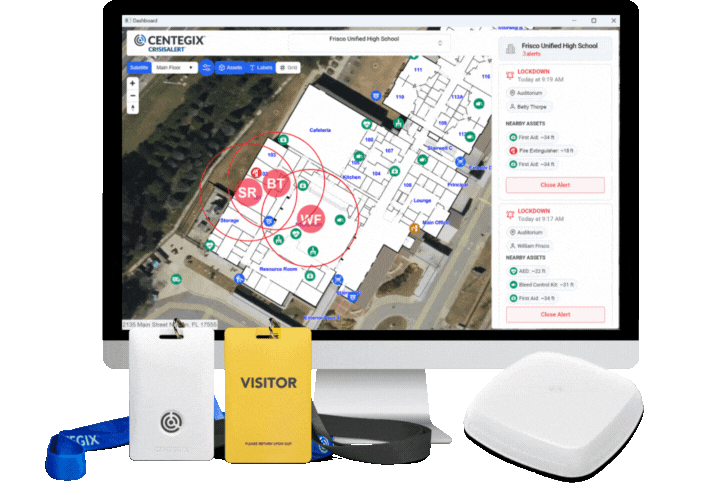A scary trend is happening in our country: workplace violence is rising. In 2020, workplace assault resulted in 20,050 injuries and 392 fatalities in the United States. Industries like healthcare and education hold some of the highest rates of attacks at the workplace, as well as some of the largest shortages of workers. Every place of employment must implement a workplace violence safety plan that is fast-acting, easily accessible, and discreet to protect the welfare of their staff.
What is Workplace Violence?
Workplace violence is classified into four major categories:
- Criminal intent: Perpetrator has no relationship to the business and is committing a crime in conjunction with violence.
- Customer-on-worker: The perpetrator is a client, and the victim or victims are employees of the workplace in question.
- Worker-on-worker: The victim and the perpetrator are employed by the business where the incident occurs.
- Personal relationship: Perpetrator has a personal relationship with an employee and commits violence against them at the workplace, posing a threat to them and their coworkers.
The most common type of workplace violence in healthcare is customer-on-worker. These attacks most frequently occur in psychiatric and geriatric facilities, emergency rooms, and waiting rooms. Emotions run high in these places, sometimes leading to violence against healthcare workers.
How Common is Workplace Violence?

Workplace violence in healthcare
Anybody can become a victim of workplace violence, as violent crime can occur in any location. But there are certain industries with higher trends of workplace violence, and healthcare is one of them.
Workplace violence in healthcare is a pervasive problem. In 2020, 10.3 out of every 10,000 full-time workers sustained injuries resulting from assaults and violent acts. The rate for nursing and personal care facility workers is even higher, with a rate of 21.8 out of 10,000 workers. Compare this to the private industry as a whole, which has a rate of under 5 incidents for every 10,000 full-time workers. Many healthcare workers not included in these statistics experience violence or threats of violence without injury.
In an industry with a shortage of workers, healthcare employees feel unsafe. The majority of them will have become a victim of workplace violence at some point in their career.
Implementing a Workplace Violence Safety Plan
The world we live in is unpredictable, but it’s possible to take measures to prepare for the possibility of workplace violence. Workplace violence in healthcare can be addressed by planning, rather than reacting in the event of an emergency.
What does this look like? A workplace violence safety plan will vary depending on the environment, the building layout, the tools in place, and other factors.
Some things to keep in mind for a safety plan that reduces workplace violence in healthcare settings:
- A fast and discreet emergency plan: The more quickly the safety plan is implemented, the more likely everyone will emerge safely.
- Employee training: Everybody should know what to do in case of an emergency.
- Zero tolerance for violence: Knowing the signs and when to set a plan in motion can make the work environment more secure.
Evaluating your Workplace Safety Plan
How do people call for help in the workplace? What happens once that call for help has been placed? How is everybody on the campus alerted to the emergency and instructed on what to do? Traditional methods have their pros and cons.
Intercoms are used frequently in hospital settings. But emergency messages can become lost among other announcements and the day-to-day noise of a hospital floor. Listening to instructions on an intercom can become difficult or impossible in an emergency, especially if anyone panics.
A victim or bystander can use their cell phone immediately to call for help without depending on a chain of command. But, trusting cell phones is unreliable. Not every person carries their personal device on them at work. Healthcare workers work long shifts and the phone might lose its battery. Also, cell phone reception can be spotty in healthcare buildings. Somebody can call the police quickly with a cell phone, but they cannot alert everybody in the building with one call. All that to say: none of these other forms of communication can reliably and instantly notify everyone of an emergency situation. This can cost precious time in getting everybody to safety.
Discretion Can Save Lives

Workplace violence in healthcare
Many incidents of workplace violence in clinical settings involve attacks from patients. Some of these incidents can be escalated unintentionally by the emergency response. However, a workplace violence safety plan that gives every employee the ability to quickly and quietly report when they feel threatened allows them to focus on de-escalating or getting to safety while knowing a swift response is on the way.
A wearable emergency button can be worn discreetly alongside an employee badge and activated without anyone noticing, notifying administrators and security personnel that an employee is in distress and needs immediate help.
Achieving Hospital Safety
CENTEGIX’s CrisisAlert badge can initiate an alert to administrators with the push of a button, including the exact location of the incident.
The wearable emergency button provides a campus-wide communication system to every healthcare staff member. Even as nurses are walking to their cars at the end of a long shift, they can call for help with the CrisisAlert badge.
The CrisisAlert badge helps resolve workplace violence incidents as quickly as possible.
Hospitals and other healthcare facilities don’t close their doors for weekends or holidays. CENTEGIX’s hospital safety solution can be installed with minimal disruption to patient care. The installation requires no alterations to physical structures or electrical wiring.
The CrisisAlert system utilizes a powerful blend of hardware, software, and wireless technologies to ensure an immediate, accurate, and reliable emergency response.










